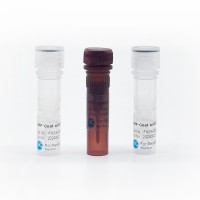Preparation of a Phage DNA Fragment Library for Whole Genome Shotgun Sequencing
互联网
773
The most efficient method to determine the genomic sequence of a dsDNA phage is to use a whole genome shotgun approach (WGSA). Preparation of a library where each genomic fragment has an equal chance of being represented is critical to the success of the WGSA. For many phages, there are regions of the genome likely to be under-represented in the shotgun library, which results in more gaps in the shotgun assembly than predicted by the Poisson distribution. However, as phage genomes are relatively small, this increased number of gaps does not present an insurmountable impediment to using the WGSA. This chapter will focus on construction of a high-quality random library and sequence analysis of this library in a 96-well format. Techniques are described for the mechanical fragmentation of genomic DNA into 2 kb average size fragments, preparation of the fragmented DNA for shotgun cloning, and advice on the choice of cloning vector for library preparation. Protocols for deepwell block culture, plasmid isolation, and sequencing in 96-well format are given. The rationale for determining the total number of random clones from a library to sequence for a 50 and 150 kb genome is explained. The steps involved in going from hundreds of shotgun sequencing traces to generating contigs will be outlined as well as how to close gaps in the sequence by primer walking on phage DNA and PCR-generated templates. Finally, examples will be given of how biological information about the phage genomic termini can be derived by analysis of the
organization
of individual clones in the shotgun sequence assembly. Specific examples are given for the circularly permuted termini of
pac
type phages, the direct terminal repeats found in most T7-like phages, variable host DNA at either end as in the Mu-like phages, and the
and
overhanging ends of
cos
type phages. The end result of these steps is the entire DNA sequence of a novel phage, ready for gene prediction.









